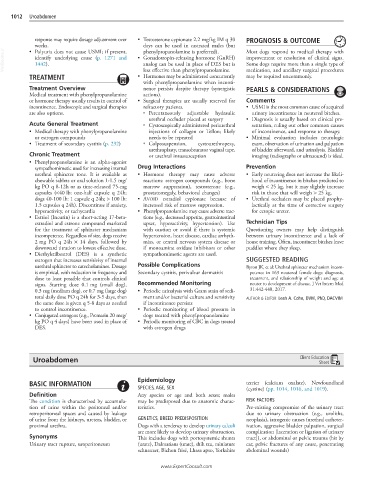Page 2023 - Cote clinical veterinary advisor dogs and cats 4th
P. 2023
1012 Uroabdomen
response may require dosage adjustment over • Testosterone cypionate 2.2 mg/kg IM q 30 PROGNOSIS & OUTCOME
weeks. days can be used in castrated males (but Most dogs respond to medical therapy with
VetBooks.ir identify underlying cause (p. 1271 and • Gonadotropin-releasing hormone (GnRH) improvement or resolution of clinical signs.
phenylpropanolamine is preferred).
• Polyuria does not cause USMI; if present,
Some dogs require more than a single type of
analog can be used in place of DES but is
1442).
less effective than phenylpropanolamine.
may be required uncommonly.
TREATMENT • Hormones may be administered concurrently medication, and ancillary surgical procedures
with phenylpropanolamine when inconti-
Treatment Overview nence persists despite therapy (synergistic PEARLS & CONSIDERATIONS
Medical treatment with phenylpropanolamine actions).
or hormone therapy usually results in control of • Surgical therapies are usually reserved for Comments
incontinence. Endoscopic and surgical therapies refractory patients. • USMI is the most common cause of acquired
are also options. ○ Percutaneously adjustable hydraulic urinary incontinence in neutered bitches.
urethral occluder placed at surgery • Diagnosis is usually based on clinical pre-
Acute General Treatment ○ Cystoscopically administered periurethral sentation, ruling out other common causes
• Medical therapy with phenylpropanolamine injections of collagen or Teflon; likely of incontinence, and response to therapy.
or estrogen compounds needs to be repeated • Minimal evaluation includes neurologic
• Treatment of secondary cystitis (p. 232) ○ Colposuspension, cystourethropexy, exam, observation of urination and palpation
urethroplasty, transobturator vaginal tape, of bladder afterward, and urinalysis. Bladder
Chronic Treatment or urethral intussusception imaging (radiographs or ultrasound) is ideal.
• Phenylpropanolamine is an alpha-agonist
sympathomimetic used for increasing internal Drug Interactions Prevention
urethral sphincter tone. It is available as • Hormone therapy may cause adverse • Early neutering does not increase the likeli-
chewable tablets or oral solution 1-1.5 mg/ reactions: estrogen compounds (e.g., bone hood of incontinence in bitches predicted to
kg PO q 8-12h or as time-released 75-mg marrow suppression), testosterone (e.g., weigh < 25 kg, but it may slightly increase
capsules (<40 lb: one-half capsule q 24h; prostatomegaly, behavioral changes) risk in those that will weigh > 25 kg.
dogs 40-100 lb: 1 capsule q 24h; > 100 lb: • AVOID estradiol cypionate because of • Urethral occluders may be placed prophy-
1.5 capsules q 24h). Discontinue if anxiety, increased risk of marrow suppression. lactically at the time of corrective surgery
hyperactivity, or tachycardia • Phenylpropanolamine may cause adverse reac- for ectopic ureter.
• Estriol (Incurin) is a short-acting 17-beta- tions (e.g., decreased appetite, gastrointestinal
estradiol and estrone compound marketed upset, hyperactivity, hypertension). Use Technician Tips
for the treatment of sphincter mechanism with caution or avoid if there is systemic Questioning owners may help distinguish
incompetence. Regardless of size, dogs receive hypertension, heart disease, cardiac arrhyth- between urinary incontinence and a lack of
2 mg PO q 24h × 14 days, followed by mias, or central nervous system disease or house training. Often, incontinent bitches leave
downward titration to lowest effective dose. if monoamine oxidase inhibitors or other puddles where they sleep.
• Diethylstilbestrol (DES) is a synthetic sympathomimetic agents are used.
estrogen that increases sensitivity of internal SUGGESTED READING
urethral sphincter to catecholamines. Dosage Possible Complications Byron JK, et al: Urethral sphincter mechanism incom-
is empirical, with reduction in frequency and Secondary cystitis, perivulvar dermatitis petence in 163 neutered female dogs: diagnosis,
dose to least possible that controls clinical treatment, and relationship of weight and age at
signs. Starting dose 0.1 mg (small dog), Recommended Monitoring neuter to development of disease. J Vet Intern Med
0.3 mg (medium dog), or 0.7 mg (large dog) • Periodic urinalysis with Gram stain of sedi- 31:442-448, 2017.
total daily dose PO q 24h for 3-5 days, then ment and/or bacterial culture and sensitivity AUTHOR & EDITOR: Leah A. Cohn, DVM, PhD, DACVIM
the same dose is given q 5-8 days as needed if incontinence persists
to control incontinence. • Periodic monitoring of blood pressure in
• Conjugated estrogens (e.g., Premarin 20 mcg/ dogs treated with phenylpropanolamine
kg PO q 4 days) have been used in place of • Periodic monitoring of CBC in dogs treated
DES. with estrogen drugs
Uroabdomen Client Education
Sheet
Epidemiology
BASIC INFORMATION terrier (calcium oxalate), Newfoundland
SPECIES, AGE, SEX (cystine) (pp. 1014, 1016, and 1019).
Definition Any species or age and both sexes; males
The condition is characterized by accumula- may be predisposed due to anatomic charac- RISK FACTORS
tion of urine within the peritoneal and/or teristics. Pre-existing compromise of the urinary tract
retroperitoneal spaces and caused by leakage due to urinary obstruction (e.g., uroliths,
of urine from the kidneys, ureters, bladder, or GENETICS, BREED PREDISPOSITION neoplasia), iatrogenic causes (urethral catheter-
proximal urethra. Dogs with a tendency to develop urinary calculi ization, aggressive bladder palpation, surgical
are more likely to develop urinary obstruction. complication [laceration or ligation of urinary
Synonyms This includes dogs with portosystemic shunts tract]), or abdominal or pelvic trauma (hit by
Urinary tract rupture, uroperitoneum (urate), Dalmatians (urate), shih tzu, miniature car, pelvic fractures of any cause, penetrating
schnauzer, Bichon frisé, Lhasa apso, Yorkshire abdominal wounds)
www.ExpertConsult.com

